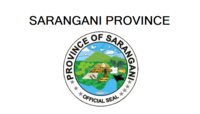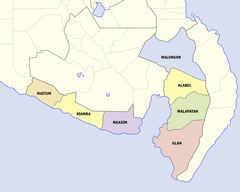Sarangani
Sarangani (Cebuano: Lalawigan sa Sarangani; Hiligaynon: Kapuoran sang Sarangani; Ilocano: Probinsia ti Sarangani; Filipino: Lalawigan ng Sarangani) is a province in the Philippines located in the Soccsksargen region. Its capital is Alabel. With a 230-kilometre (140 mi) coastline along the Sarangani Bay and Celebes Sea, the province is at the southernmost tip of Mindanao island, and borders South Cotabato and Davao del Sur to the north, Davao Occidental to the east, and the Celebes Sea to the south.
Sarangani | |
|---|---|
| Province of Sarangani | |
 Flag  Seal | |
| Anthem: Sarangani, Land of Beauty | |
 Location in the Philippines | |
| Coordinates: 5°52′N 125°17′E | |
| Country | Philippines |
| Region | Soccsksargen (Region XII) |
| Founded | November 28, 1992 |
| Capital | Alabel |
| Government | |
| • Type | Sangguniang Panlalawigan |
| • Governor | Steve C. Solon (UNA/PCM) |
| • Vice Governor | Elmer T. de Peralta |
| • Congressman | Rogelio D. Pacquiao |
| • Sangguniang Panlalawigan | Members
|
| Area | |
| • Total | 3,601.25 km2 (1,390.45 sq mi) |
| Area rank | 37th out of 81 |
| Highest elevation (Mount Busa) | 2,064 m (6,772 ft) |
| Population (2015 census)[2] | |
| • Total | 544,261 |
| • Rank | 55th out of 81 |
| • Density | 150/km2 (390/sq mi) |
| • Density rank | 58th out of 81 |
| Divisions | |
| • Independent cities | 0 |
| • Component cities | 0 |
| • Municipalities | |
| • Barangays | 141 |
| • Districts | Lone district of Sarangani |
| Time zone | UTC+8 (PST) |
| ZIP code | 9501–9503, 9514–9517 |
| IDD : area code | +63 (0)83 |
| ISO 3166 code | PH-SAR |
| Spoken languages | |
| Income classification | 2nd class |
| Website | www |
Sarangani is part of the South Cotabato-Cotabato-Sultan Kudarat-Sarangani-General Santos City (SOCCSKSARGEN) development cluster, and is linked by paved roads to the international airport and harbor of General Santos City.
The province is divided into two sections, separated by the Sarangani Bay and General Santos City, and it used to be part of South Cotabato until it was made an independent province in 1992.[3]
History
The earliest civilization in the province can be found in Maitum, Sarangani, where the Maitum Anthropomorphic Pottery or Maitum Jars were found. The jars have been dated to approximately 5 BC to 370 AD, one of the oldest in the entire Southeast Asian region and the Philippines. The discovery testified to the long history of cultural exchanges in Sarangani and its people.
The island of Sarangani (now part of Davao Occidental) was named by Spanish explorer Ruy López de Villalobos in 1543 as Antonia, in honor of Antonio de Mendoza y Pacheco who commissioned the Villalobos expedition to the Philippines. The early inhabitants who first inhabited Sarangani were the indigenous natives, called MunaTo, a native term for "first people."[4]
In 1942, the Japanese troops occupied Southern Cotabato. In 1945, Filipino troops of the 6th, 10th, 101st and 102nd Infantry Division of the Philippine Commonwealth Army and 10th Constabulary Regiment of the Philippine Constabulary entered in and liberated Southern Cotabato and fought against the Japanese Imperial Army forces during the Battle of Cotabato at the end of World War II under the Japanese Occupation.
Before its inception in 1992, Sarangani was part of South Cotabato as the Third District of South Cotabato. The province was created by Republic Act No. 7228 on March 16, 1992,[3] penned by Congressman James L. Chiongbian. His wife, Priscilla L. Chiongbian, was the first Governor of Sarangani.
Geography
Sarangani covers a total area of 3,601.25 square kilometres (1,390.45 sq mi)[5] occupying the southern tip of the SOCCSKSARGEN in central Mindanao. The province is bordered on the central-north by South Cotabato, northeast by Davao del Sur, east by Davao Occidental, south by the Sarangani Bay and Celebes Sea, and northwest by Sultan Kudarat.

Sarangani is divided into two (eastern and western) sections, separated by the Sarangani Bay and General Santos City in the middle. The western portion comprises the towns of Maitum, Kiamba, and Maasim, and is bounded on the north by South Cotabato and on the northwest by Sultan Kudarat. The eastern section consists of Alabel, Glan, Malapatan, and Malungon.
Administrative divisions
Sarangani comprises seven municipalities. A single legislative district encompasses all towns.[5]

| Municipality [lower-roman 1] | Population | ±% p.a. | Area[5] | Density (2015) | Barangay | |||||||
|---|---|---|---|---|---|---|---|---|---|---|---|---|
| (2015)[2] | (2010)[6] | km2 | sq mi | /km2 | /sq mi | |||||||
| Alabel | † | 14.8% | 80,359 | 75,477 | +1.20% | 510.98 | 197.29 | 160 | 410 | 13 | ||
| Glan | 21.7% | 118,263 | 106,518 | +2.01% | 610.30 | 235.64 | 190 | 490 | 31 | |||
| Kiamba | 11.2% | 61,058 | 54,871 | +2.06% | 328.68 | 126.90 | 190 | 490 | 19 | |||
| Maasim | 10.9% | 59,468 | 52,933 | +2.24% | 500.43 | 193.22 | 120 | 310 | 16 | |||
| Maitum | 8.2% | 44,595 | 41,675 | +1.30% | 290.66 | 112.22 | 150 | 390 | 19 | |||
| Malapatan | 14.1% | 76,914 | 72,386 | +1.16% | 609.28 | 235.24 | 130 | 340 | 12 | |||
| Malungon | 19.0% | 103,604 | 95,044 | +1.66% | 750.92 | 289.93 | 140 | 360 | 31 | |||
| Total | 544,261 | 498,904 | +1.67% | 3,601.25 | 1,390.45 | 150 | 390 | 141 | ||||
| † Provincial capital | Municipality | |||||||||||
| ||||||||||||
Demographics
|
| ||||||||||||||||||||||||
| Source: Philippine Statistics Authority[2][6][7] | |||||||||||||||||||||||||
The population of Sarangani in the 2015 census was 544,261 people,[2] with a density of 150 inhabitants per square kilometre or 390 inhabitants per square mile.
Religion
Christianity is the majority religion in the province with a total of 79% (48% Roman Catholicism [8] and 31% evangelicals).[9] Other religious minorities are Islam (9%)[10] and Iglesia Ni Cristo (2%).[11] The remainder is usually divided among other Christian churches.
Economy
Coconut, corn, rice, banana, mango, durian, rubber, and sugarcane are major crops now being planted by the inhabitants. The province has plantations (mango, banana, pineapple, asparagus), cattle ranches, and commercial fishponds that have been operating in the area, some of which having existed as far back as 40 years.
Electricity comes from the National Power Corporation, and augmented by a 50 MW power plant in Alabel, the province's capital. Water is provided for by sustainable spring development projects.
Government
|
Elected Officials (2016-2019)
Elected Officials (2013-2016)
Elected Officials (2010-2013)
|
Elected Officials (2007-2010)
Elected Officials (2004-2007)
|
Tourism
Sarangani celebrates its foundation anniversary every November, named as MunaTo Festival.[12]
Sarangani has ancient burial jars, discovered by archaeologists from the National Museum in Ayub Cave in Maitum, in 1991 and in 2008, and at Sagel Cave in Maitum (now declared by National Historical Institute as a national historical site). Amid Mindanao's armed conflicts, artifacts found thereat prove settlements of pre-historic civilization in Maitum.[12][13]
See also
- Jinkee Pacquiao - wife of Manny Paquiao and former Sarangani vice governor (2013). Her family is from Sarangani.
References
- "List of Provinces". PSGC Interactive. Makati City, Philippines: National Statistical Coordination Board. Retrieved 13 May 2014.
- Census of Population (2015). "Region XII (Soccsksargen)". Total Population by Province, City, Municipality and Barangay. PSA. Retrieved 20 June 2016.
- "An Act Creating the Province of Sarangani" (PDF). House of Representatives of the Philippines. 16 March 1992. Archived from the original (PDF) on 7 February 2016. Retrieved 8 January 2016.
- balita.ph/2008, Man-made island resort now a Sarangani landmark
- "Province: Sarangani". PSGC Interactive. Quezon City, Philippines: Philippine Statistics Authority. Retrieved 8 January 2016.
- Census of Population and Housing (2010). "Region XII (Soccsksargen)". Total Population by Province, City, Municipality and Barangay. NSO. Retrieved 29 June 2016.
- Censuses of Population (1903–2007). "Region XII (Soccsksargen)". Table 1. Population Enumerated in Various Censuses by Province/Highly Urbanized City: 1903 to 2007. NSO.
- https://www.rappler.com/newsbreak/iq/81162-map-catholicism-philippines
- http://philchal.org/dawn/nationalsum.asp?usersort=def_asc
- https://www.rappler.com/newsbreak/iq/99572-map-islam-philippines
- https://www.rappler.com/newsbreak/iq/64391-map-iglesia-ni-cristo-population-philippines
- "'MunaTo' festival". Manila Bulletin. 29 November 2013. Retrieved 17 April 2016.
The provincial government started their celebration of its 21st foundation anniversary on Thursday and officially opened its 11th “MunaTo Festival” starting November 27 and will run up to December 6, this year.
- Pelima, Russtum G. (10 November 2008). "Island resort now Sarangani landmark". Philippine Information Agency. PIO Sarangani/ICC GenSan. Archived from the original on 11 February 2009. Retrieved 17 April 2016.
Despite armed conflicts occurring in Mindanao, artifacts found by archaeologists from the National Museum in Ayub Cave in 1991 and Sagel Cave this year prove settlements of pre-historic civilization in Maitum.
External links


- Official Website of the Provincial Government of Sarangani
- Local Governance Performance Management System


